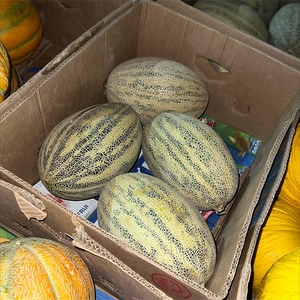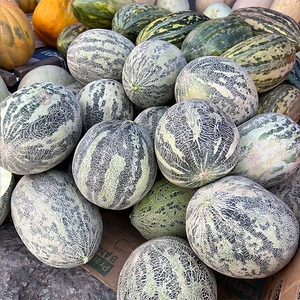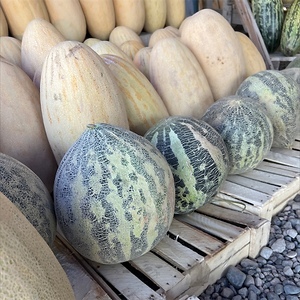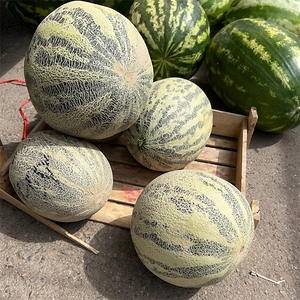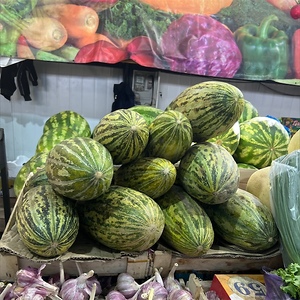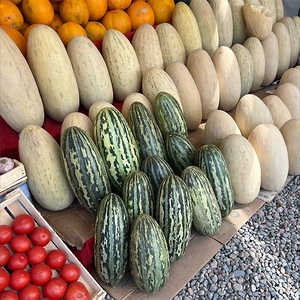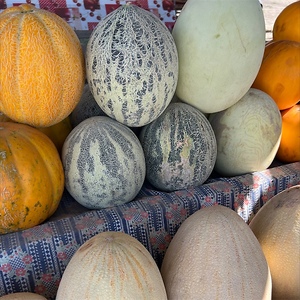


Gurbek Melons
Estimated Inventory, lb : 0
Description/Taste
Gurbek melons are medium to large fruits, averaging 6 to 13 pounds, and have an oval to round shape. The rind is firm, fibrous, and has a smooth, grey-green base, covered in dark green mottling and a rough, light brown netting. Underneath the surface, the flesh is dense, aqueous, thick, and pale green to white, encasing a central cavity filled with ivory, oblong seeds suspended in a viscous liquid. Gurbek melons, when first harvested, have a mild, vegetal taste reminiscent of a cucumber, and as the melon is stored, it develops a very sweet flavor.
Seasons/Availability
Gurbek melons are available in the summer through fall in Central Asia.
Current Facts
Gurbek melons, botanically classified as Cucumis melo, are a sweet, Uzbek variety belonging to the Cucurbitaceae family. There are over 160 types of melons found in Uzbekistan, and 36 of those varieties have been studied for commercial cultivation. Melons are also one of the most important crops grown throughout Central Asia and are an essential hydration source during the hot summer months. When in season, local markets are filled with melons emitting strong, honeyed aromas, enticing visitors to purchase the sweet, juicy fruits. Gurbek melons are a famous variety highly favored for its sweet taste and juicy flesh. The cultivar is also being cultivated in Turkmenistan, and the variety has become so popular that some farms sell the fruits directly out of the field and will sell out before they can bring the melon into the marketplace.
Nutritional Value
Gurbek melons are a good source of vitamin C, an antioxidant that can strengthen the immune system, reduce inflammation, and improve collagen production within the skin. The melons also contain fiber to stimulate digestion and provide smaller amounts of iron, magnesium, zinc, calcium, and potassium. In Central Asia, it is believed that consuming melons can help improve the skin, hair, and eyes, stimulate digestion, and increase fluid levels within the body.
Applications
Gurbek melons are best suited for raw applications as their sweet, juicy flesh is showcased when consumed straight, out-of-hand. The flesh can be eaten as a refreshing snack, or it can be sliced and tossed into green salads, mixed into fruit bowls, displayed on appetizer platters, or blended into beverages such as smoothies, juices, and cocktails. In addition to fresh preparations, Gurbek melons can be cooked into honey, jam, jellies, and fillings for cakes, pies, and mousses. They can also be candied to enhance their sweet taste or canned for extended use. In Uzbekistan, melons are popularly dried into thin strips and are sold in packages or braided together as a chewy, date-like snack. Dried melon pieces are also offered before and after meals, sometimes with tea. Beyond the flesh, Gurbek melon seeds can be roasted, lightly coated in salt, and eaten. Gurbek melons pair well with vanilla, citrus, herbs such as mint, basil, and cilantro, ginger, nuts, and other dried fruits. Whole Gurbek melons will keep for a couple of weeks when stored in a cool and dry place. In Uzbekistan, some melon varieties, including Gurbek melons, are traditionally stored in straw bags and hung from the ceilings of kaun-khana, which are special buildings designed to help preserve the fruits throughout the season.
Ethnic/Cultural Info
In Turkmenistan, Gurbek melons are celebrated during Gawun Bayramy, also known as the “day of Turkmen melon.” The annual festival is held in august and was recognized by Turkmen leader Saparmurat Niyazov as a national holiday beginning in 1994. During the holiday, local melon varieties are proudly displayed in large pyramids, creating a striking visual display, and the melons are also used to decorate vendor stalls, restaurants, and tables. Many different events, including contests, concerts, art exhibitions, and educational talks are held across the country, and in the markets, melon growers encourage visitors to sample the varieties and purchase a melon for home consumption. Gawun Bayramy is a time for celebration and giving thanks for the thriving melon industry in Turkmenistan. In addition to melon festivities, prayers are offered in the Russian Orthodox Churches to bless the fruits of the new harvest.
Geography/History
Melons have been cultivated in Central Asia for over 2,000 years and were transported along trade routes into China, India, and the Middle East sometime during the 2nd century BCE. Gurbek melons are believed to be native to Uzbekistan and are currently being studied at KKRIA, or the Kara-Kalpak Research Institute of Agriculture, which is also home to a portion of one of the world’s largest melon germplasm collections. Today Gurbek melons can be found in the Khorezm region of Uzbekistan, which is one of the oldest cultivation areas in Central Asia and can also be found in Karakalpakstan and Dashoguz in Northern Turkmenistan.
Recipe Ideas
Recipes that include Gurbek Melons. One
| Simply Recipes |
|
Fruit Leather |
| Food 52 |
|
Melon Juice |
| Food Republic |
|
Melon Jam |
| Online Magazine |
|
Dried Melon |



